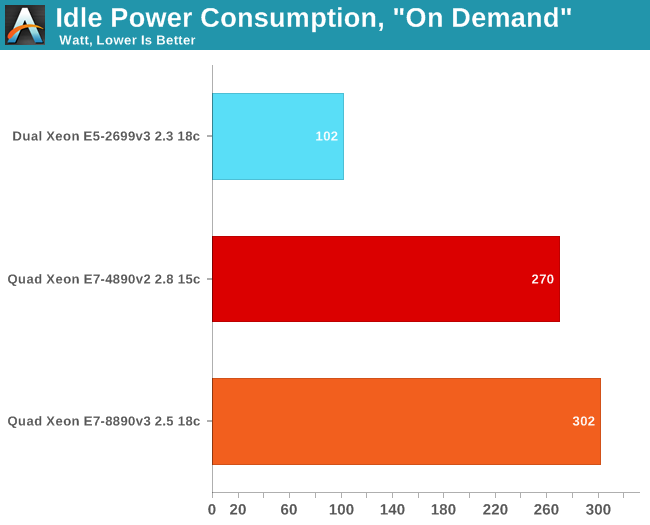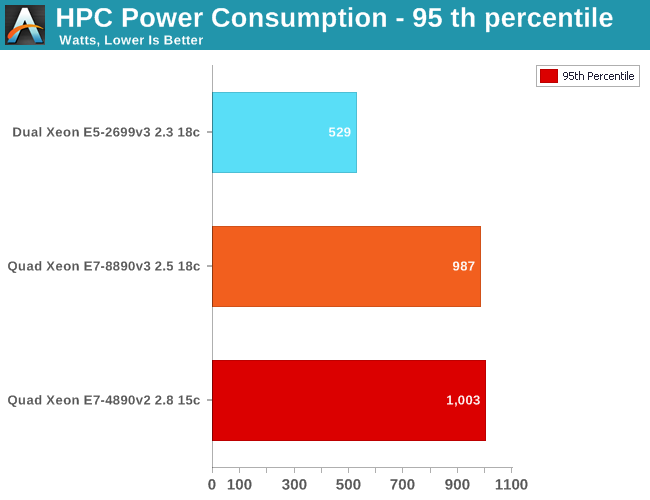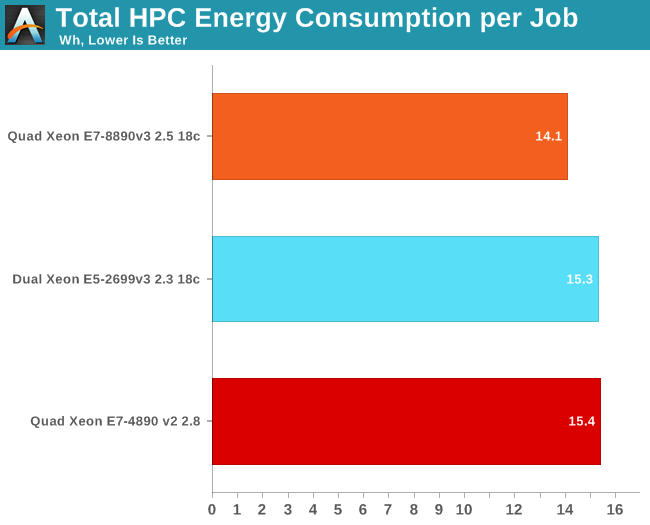The Intel Xeon E7-8800 v3 Review: The POWER8 Killer?
by Johan De Gelas on May 8, 2015 8:00 AM EST- Posted in
- CPUs
- IT Computing
- Intel
- Xeon
- Haswell
- Enterprise
- server
- Enterprise CPUs
- POWER
- POWER8
HPC: Watts per Job
Last, but not least, we have a look at power consumption. First we measure idle power consumption.

We did not expect the E7 v3 to consume more energy at idle than the previous E7, but sure enough it did. Maybe the DDR4 memory buffers (Jordan Creek 2) need more energy than the previous ones?
For load power testing we used the OpenFOAM test and measured at the 95th percentile, which is basically the power consumed when processing the most parallel part.

These quad socket systems are made for reliability, and not quite as much as for performance-per-watt. The end result is that these quad socket servers need about as much power as your fabric iron. To put this in perspective: the Xeon E5-2699v3 is considered a real power hog among the Xeon E5s. Most of the other dual Xeon E5 servers are in the 390-450W range.
Let us see how much watt we need for each OpenFOAM job.

The new Xeon E7-8890v3 is a tiny bit more efficient, but it is almost neglible.










146 Comments
View All Comments
DanNeely - Friday, May 8, 2015 - link
Intel's 94% market share is still only ~184k systems. That's tiny compared to the mainstream x86 market; and doesn't give a lot of (budgetary) room to make radical changes to CPU vs just scaling shared designs to a huger layout.theeldest - Friday, May 8, 2015 - link
184k for 4S systems. The number of 2S systems *greatly* outnumbers the 184k.Samus - Sunday, May 10, 2015 - link
by 100 orders of magnitude, easily.2S systems are everywhere these days, I picked up a Lenovo 2S Xeon system for $600 NEW (driveless, 4GB RAM) from CDW.
4S, on the other hand, is considerably more rare and starts at many thousands, even with 1 CPU included.
erple2 - Sunday, May 10, 2015 - link
Well, maybe 2 orders of magnitude. 100 orders of magnitude would imply, based on the 184k 4S systems, more 2S systems than atoms in the universe. Ok, I made that up, I don't know how many atoms are in the universe, but 10^100 is a really big number. Well, 10^105, if we assume 184k 4S systems.I think you meant 2 orders of magnitude.
mapesdhs - Sunday, May 10, 2015 - link
Yeah, that made me smile too, but we know what he meant. ;)evolucion8 - Monday, May 11, 2015 - link
That would be right if Intel cores are wide enough which aren't compared to IBM. For example, according to this review, enabling two way SMT boosted the performace to 45% and adding two more threads added 30% more performance. On the other hand, enabling two way SMT on the latest i7 architecture can only go up to 30% on the best case scenario.chris471 - Friday, May 8, 2015 - link
Great article, and I'm looking forward to see more Power systems.I would have loved to see additional benchmarks with gcc flags -march=native -Ofast. Should not change stream triad results, but I think 7zip might profit more on Power than on Xeon. Most software is not affected by the implied -ffast-math.
close - Friday, May 8, 2015 - link
It reminds me of the time when Apple gave up on PowerPC in mobiles because the new G5s were absolute power guzzlers and made space heaters jealous. And then gave up completely and switched to Intel because the 2 dual core PowerPC 970MP CPUs at 2.5GHz managed to pull 250W of power and needed liquid cooling to be manageable.IBM is learning nothing from past mistakes. They couldn't adapt to what the market wanted and the more nimble competition was delivering 25-30 years ago when fighting Microsoft, it already lost business to Intel (which is actually only nimble by comparison), and it's still doing business and building hardware like we're back in the '70s mainframe age.
name99 - Friday, May 8, 2015 - link
You are assuming that the markets IBM sells into care about the things you appear to care about (in particular CPU performance per watt). This is a VERY dubious assumption.The HPC users MAY care (but I'd need to see evidence of that). For the business users, the cost of the software running on these systems dwarfs the lifetime cost of their electricity.
SuperVeloce - Saturday, May 9, 2015 - link
They surely care. Why wouldn't they. A whole server rack or many of them in fact do use quite a bit of power. And cooling the server room is very expensive.